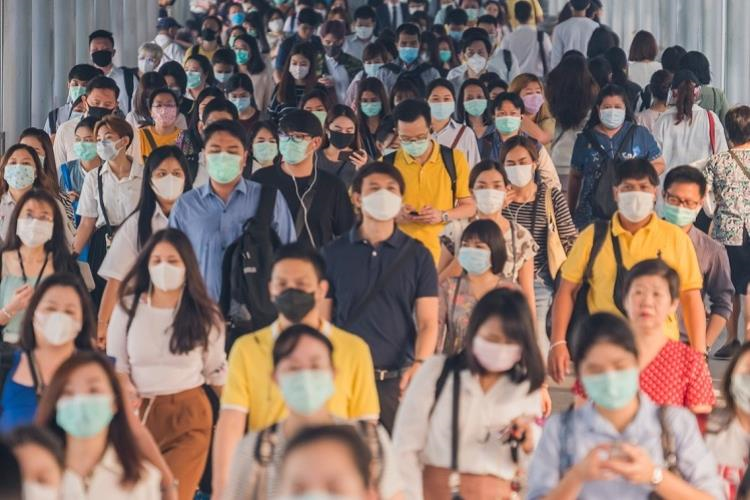Topics
Throughout Asia, floods are a prevalent seasonal geo-environmental occurrence. In Malaysia, we face regular flooding over two monsoon seasons, typically around late May to September and November to March.
Flash floods from intensive heavy rains and river flooding as a result of rivers bursting through their banks are frequent recurrence during the flood season. Massive evacuation and disaster relief efforts have been necessary in flood-prone areas in Malaysia throughout the last decade.
Malaysians are exposed to the risk of infectious and waterborne disease outbreaks during the flood season.
What are infectious diseases?
Infectious diseases are contagious diseases caused by pathogenic microorganisms (pathogens) such as bacteria, viruses, parasites, and fungi. These diseases can spread directly or indirectly from one individual to another.
World Health Organization (WHO) reported a total of 52,977 dengue cases in Malaysia from January to the start of November 2022 in their update on the Western Pacific’s dengue situation. 37 of these cases were fatal.
The incidence rate of tuberculosis is 92 per 100,000 people in Malaysia. There were 25,173 cases recorded nationally in 2018, which translated to almost 70 new cases daily.
What are the common infectious diseases during floods in Malaysia?
The local tropical wet season is characterised by heavy, regular rainfall and monsoon winds. The possibility of flooding increases, and this leads to fluctuations in water levels, storm surges, or the hammering of waves.
Subsequently, the flooding aftermath facilitates the breeding of mosquitoes, and later outbreaks of infectious diseases. Some of the infectious disease cases prevalent in Malaysia in the wake of flooding are bacterial diarrhoea, vector-borne diseases such as dengue fever, and water-contact diseases such as leptospirosis.
Here are some common infectious diseases in Malaysia during the flooding season.
- 1. Cholera
Cholera is a diarrheal illness caused by the infection of Vibrio cholerae bacteria. It primarily occurs when humans consume contaminated food or water. Cholera infection symptoms are usually mild but can escalate with more severe symptoms such as shock and seizures.
- 2. Typhoid fever
Typhoid fever is a type of bacterial infection caused by Salmonella enterica. This disease spreads mainly through contaminated food, water, or close contact with infected patients. Most patients show a common symptom of sustained high fevers, which, left untreated, can potentially be fatal.
- 3. Dysentery and food poisoning
Dysentery is caused by a few types of bacteria and parasites. The bacteria Shigella that causes dysentery spreads through contaminated food or water. Infection symptoms include bloody diarrhoea, abdominal pain, fever, cramps, and malaise, which is the feeling of discomfort, illness, or unease.
- 4. Hepatitis A
Hepatitis A is a viral infection particularly spread by consumption of food and water contaminated with faecal matter. It is a common infection in areas with poor sanitation Symptoms include fever, jaundice, and diarrhoea.
- 5. Leptospirosis
Leptospirosis is a bacterial infection caused by Leptospira. Leptospirosis outbreaks are common in areas that experience recurrent flooding. This disease mainly occurs via contact with water or food contaminated by animal urine.
Symptoms include high fever, incessant headache, vomiting, jaundice, and diarrhoea. If left untreated, the disease may lead to kidney damage, meningitis, liver failure, or respiratory distress.
- 6. Dengue fever
Dengue fever is a common viral infection caused by ribonucleic acid (RNA) virus from the flaviviridae family. This disease is transmitted via mosquito vectors known as Aedes aegypti.
Dengue fever manifests as a sudden onset of fever and severe headache. Shock and haemorrhage may occur in some patients, leading to death in approximately 5% of cases.
- 7. Malaria
Malaria is a common infectious disease caused by plasmodium, a single-cell parasitic protozoa. It is transmitted to humans through the bite of a female Anopheles mosquito.
Plasmodium parasites multiply in the human liver and attack red blood cells. This leads to fever cycles, sporadic sweating, and anaemia. If left untreated, malaria often leads to death or damage to vital organs due to the interruption of blood supply to the brain.
- 8. Japanese encephalitis
Japanese encephalitis is a viral brain infection spread through mosquito (Culex tritaeniorhynchus) bites. The virus is mainly found in pigs and birds but is passed to mosquitoes when they bite infected animals. This disease is common in rural areas in southeast Asia. If left untreated, it can progress to paralysis, coma, and even death.
- 9. Conjunctivitis
Conjunctivitis (also known as pinkeye) is an eye infection caused by bacterial or viral infection. This disease causes inflammation and irritation to the conjunctiva (the white eye component and the inner eyelids).
- 10. Measles
Measles is an acute viral respiratory illness characterised by a prodrome of fever, cough, total body rash, and conjunctivitis. Measles is a very contagious respiratory infection that spreads through the air by respiratory droplets as an infected individual coughs or sneezes.
Why does flooding increase the spread of infectious diseases?
The majority of infectious diseases that occur due to flooding are gastroenteritis outbreaks, respiratory infections, and epidemic diseases such as cholera, diarrhoea, and dengue fever, amongst others.
These diseases are common during flooding disasters because floods create unsanitary conditions for the breeding and multiplication of harmful pathogens and disease vectors.

How to protect yourself from diseases during and after floods in Malaysia?
Here are recommended preventive measures that can help you stay safe during the flooding season.
- 1. Get vaccinated
You can be vaccinated from certain infectious diseases such as Hepatitis A and B, influenza, and Japanese encephalitis. These vaccines help to reduce the spread of diseases to others, especially those who are immune-compromised or susceptible to infections during flooding seasons.
- 2. Practice good food hygiene
Practicing good food hygiene can be the first line of defence against a potential infectious disease outbreak because these diseases are easily spread through food and water.
- 3. Practice good personal hygiene
Personal hygiene is also an important component of infectious disease prevention during flooding seasons. Wash your hands with soap and clean water frequently or use alcohol-based hand sanitisers (consisting at least 60% alcohol).
- 4. Keep your surroundings clean
Unsanitary and poor conditions can easily escalate infectious disease spread such as leptospirosis outbreaks that typically occur through water contaminated by rodent urine. Therefore, do ensure that your surroundings are constantly kept clean following the occurrence of a flood.
- 5. Look out for breeding grounds for mosquitoes
Clear areas that contain stagnant water to prevent the breeding of mosquitos. On top of that, use mosquito nets, mosquito repellents, and install residential window screens to reduce exposure to mosquitoes that are disease vectors during flood seasons.
How are infectious diseases treated?
Flooding aftermath always lead to increased infectious disease transmission and outbreak. Flooding leads to the emergence of overcrowded shelters with poor water and sanitation conditions amongst the flood victims. There are also insufficient personal hygiene, vaccination availability, and often limited access to proper health care services.
Therefore, it is important to have access to professional emergency team of specialists at Pantai Hospital. Efficient medical services play an important role in controlling infectious disease epidemics, administer vaccines, and improve deteriorating health conditions amongst flood victims.
Make an appointment at Pantai Hospitals
If you encounter a situation that requires medical attention, please seek immediate medical attention at the Accident and Emergency (A&E) department at your nearest Pantai Hospital.
Pantai Hospitals have been accredited by the Malaysian Society for Quality in Health (MSQH) for its commitment to patient safety and service quality.
References
- Emerging and re-emerging diseases in Malaysia. Available at https://pubmed.ncbi.nlm.nih.gov/12597511/ [Accessed 12 November 2022]
- Case definitions for infectious diseases in Malaysia. Available at. https://www.moh.gov.my/moh/resources/Penerbitan/Garis%20Panduan/Pengurusan%20KEsihatan%20&%20kawalan%20pykit/Case_Definition_Of_Infectious_Disease_3rd_Edition_2017.pdf [Accessed 13 November 2022]
- Infectious diseases impacting Malaysia during COVID-19. Available at https://borgenproject.org/infectious-diseases-impacting-malaysia/ [Accessed 13 November 2022]
- Communicable diseases. Available at http://www.myhealth.gov.my/en/category/kids/kids-communicable-disease/ [Accessed 14 November 2022]
- Infectious diseases. Available at https://specialty.mims.com/infectious-diseases [Accessed 14 November 2022]
- Aedes aegypti. Available at https://www.sciencedirect.com/topics/immunology-and-microbiology/aedes-aegypti [Accessed 15 November 2022]
- Cholera - Vibrio cholerae infection. Available at https://www.cdc.gov/cholera/index.html [Accessed 15 November 2022]
- Epidemiology of tuberculosis in Sabah, Malaysia, 2012–2018. Available at https://www.ncbi.nlm.nih.gov/pmc/articles/PMC7447595/ [Accessed 15 November 2022]
- Adult Jaundice. Available at https://my.clevelandclinic.org/health/diseases/15367-adult-jaundice#:~:text=Jaundice%20is%20a%20condition%20in,t%20need%20to%20be%20treated. [Accessed 15 November 2022]
- Flaviviridae. Available at https://www.cdc.gov/vhf/virus-families/flaviviridae.html [Accessed 15 November 2022]
- Life Cycle of Anopheles Species Mosquitoes. Available at https://www.cdc.gov/mosquitoes/about/life-cycles/anopheles.html [Accessed 15 November 2022]
- Malaysia major infectious diseases. Available at https://www.indexmundi.com/malaysia/major_infectious_diseases.html [Accessed 15 November 2022]
- Salmonella enterica. Available at https://www.sciencedirect.com/topics/biochemistry-genetics-and-molecular-biology/salmonella-enterica#:~:text=Salmonella%20enterica%20is%20a%20Gram%2Dnegative%2C%20food%2Dborne%20pathogen,Salmonella%20in%20macrophages%20is%20crucial. [Accessed 15 November 2022]
- Shigella - Shigellosis. Available at https://www.cdc.gov/shigella/index.html [Accessed 15 November 2022]
- The top 10 causes of death. Available at https://www.who.int/news-room/fact-sheets/detail/the-top-10-causes-of-death [Accessed 15 November 2022]
- Update on the Dengue situation in the Western Pacific Region. Available at https://www.who.int/docs/default-source/wpro---documents/emergency/surveillance/dengue/dengue-20221006.pdf?sfvrsn=fc80101d_124#:~:text=Up%20until%20epidemiological%20week%2045,in%202021%20(CFR%200.08%25).&text=During%20epidemiological%20week%2043%20of,(2)%20deaths%20were%20reported. [Accessed 15 November 2022]







.tmb-ph800x600.webp?Culture=en&sfvrsn=b36a5f81_8)






